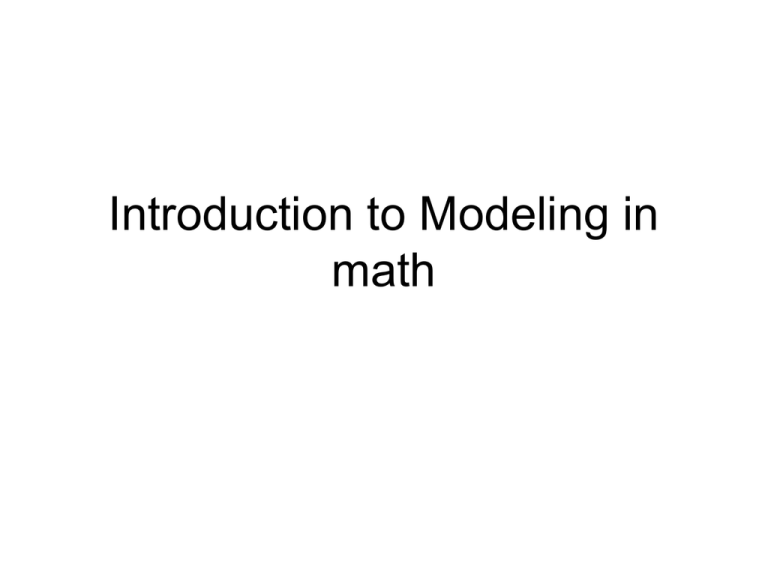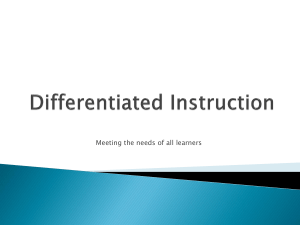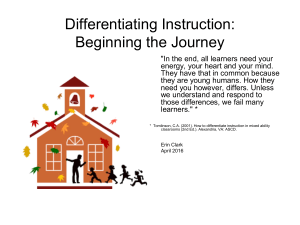Introduction to Modeling in math
advertisement

Introduction to Modeling in math What is Modeling? • Modeling is a strategy to represent the important structures of problems so they can more easily be explored and solved. • Students use physical or virtual manipulatives to act out and think through problems. Key Elements of Modeling • Students use objects--and computer versions of objects--they can see and move to engage in problem solving through sight, touch, and kinetics. • Examples of objects include: • Base-ten blocks • Colored chips or tiles • Fraction strips • Cuisenaire rods • Geoboards How Does Modeling Help Students? • Provides concrete experiences from which they can generalize. • Promotes their mathematical thinking. • Gives them a variety of tools to draw upon. • Deepens their conceptual understanding. • Builds their confidence in tackling problems. Discussion Questions 1 1. What models have you used in your classroom for which mathematical concepts? 2. What are the advantages and disadvantages of the virtual models you have used with struggling students? 3. How could you use a model to help your struggling students make that abstract concept more concrete? How Can I Support Students' Use of Modeling? Use Evidence-Based Instructional Practices • Provide clear explanations • Use varied examples, materials, and models • Provide ongoing formative assessment Differentiated Instruction • Plan instruction that considers students' readiness, learning needs, and interests. • Use a range of technology tools to: – engage learners at varying levels – engage learners in multiple ways. – offer students options for demonstrating understanding and mastery Teacher-Dependent Ways to Differentiate • By Content – Different levels of reading or resource materials, reading buddies, small group instruction, curriculum compacting, multilevel computer programs and Web Quests, audio materials, etc. • By Product – Activity choice boards, tiered activities, multi-level learning center tasks, similar readiness groups, choice in group work, varied journal prompts, mixed readiness groups with targeted roles for students, etc. • By Process – Tiered products, students choose mode of presentation to demonstrate learning, independent study, varied rubrics, mentorships, interest-based investigations Student-Dependent Ways to Differentiate • By Readiness – Options in content, topic, or theme, options in the tools needed for production, options in methods for engagement • By Profile – Consideration of gender, culture, learning styles, strengths, and weaknesses • By Process – Identification of background knowledge/gaps in learning, vary amount of direct instruction, and practice, pace of instruction, complexity of activities, and exploration of a topic Discussion Questions 2 1. How does modeling support the Common Core State Standards Math Practices? 2. What types of difficulties do your students have, and how can different types of models support their learning? 3. What role does the content of a lesson have in differentiating instruction? Provide Clear Explanations: Possible Strategies • Describe, demonstrate, and let students practice using each kind of model. • Explain the connection between each model and problem. • Use language/terms from problems to keep students focused on what models represent. Use Varied Examples, Materials, and Models: Possible Strategies • For each problem, share a range of appropriate models students can choose from. • Think aloud as you choose models to help students know when/why to use certain in ones. • Model how to use virtual manipulatives. Provide Ongoing Formative Assessment: Possible Strategies • To assess students’ understanding, ask them to explain why they choose certain models. • Watch for and help those who choose models that are too complex or simple for the task. • Ask struggling students which strategies the class has learned that might be helpful. • Give students time to respond to feedback, ask questions, and share their thinking. Use Online and Offline Tools • • • • • • • Manipulatives Interactive whiteboard Web-based applets Math drawing tools Calculators 3D design software Graphing and charting software Use Research-Based Strategies and Tools • To launch the lesson • During the learning task • As you bring closure to the lesson Discussion Questions 3 1. What do you consider when you decide which model is appropriate for a particular problem? 2. What are the advantages and disadvantages of using virtual vs. physical models? 3. What types of formative assessment have you found to be particularly useful when checking for students’ understanding of models? Disclaimer Awarded through a cooperative agreement from the U.S. Department of education, Office of Special Education Programs (OSEP), Grant #H327G090004-10, PowerUp What Works was developed by a team of experts in education, technology, differentiated instruction/UDL, and special education at the Center for Technology Implementation, operated by the American Institutes for Research (AIR) in collaboration with the Education Development Center, Inc. (EDC) and the Center for Applied Special Technology (CAST). • This document contains information from other public and private organizations that may be useful to the reader; these materials are merely examples of resources that may be available. Inclusion of this information does not constitute an endorsement by the U.S. Department of Education of any products or services offered or views expressed. This publication also contains hyperlink s and URLs created and maintained by outside organizations and provided for the reader's convenience. The Department is not responsible for the accuracy if this information. Further, the programs/models/resources featured on this site have not been extensively evaluated by CTI. This website was created and is maintained by American Institutes for Research (AIR) through funding from the U.S. Department of Education, Award # H327G090004. For more information, send an e-mail to PowerUp@air.org.






